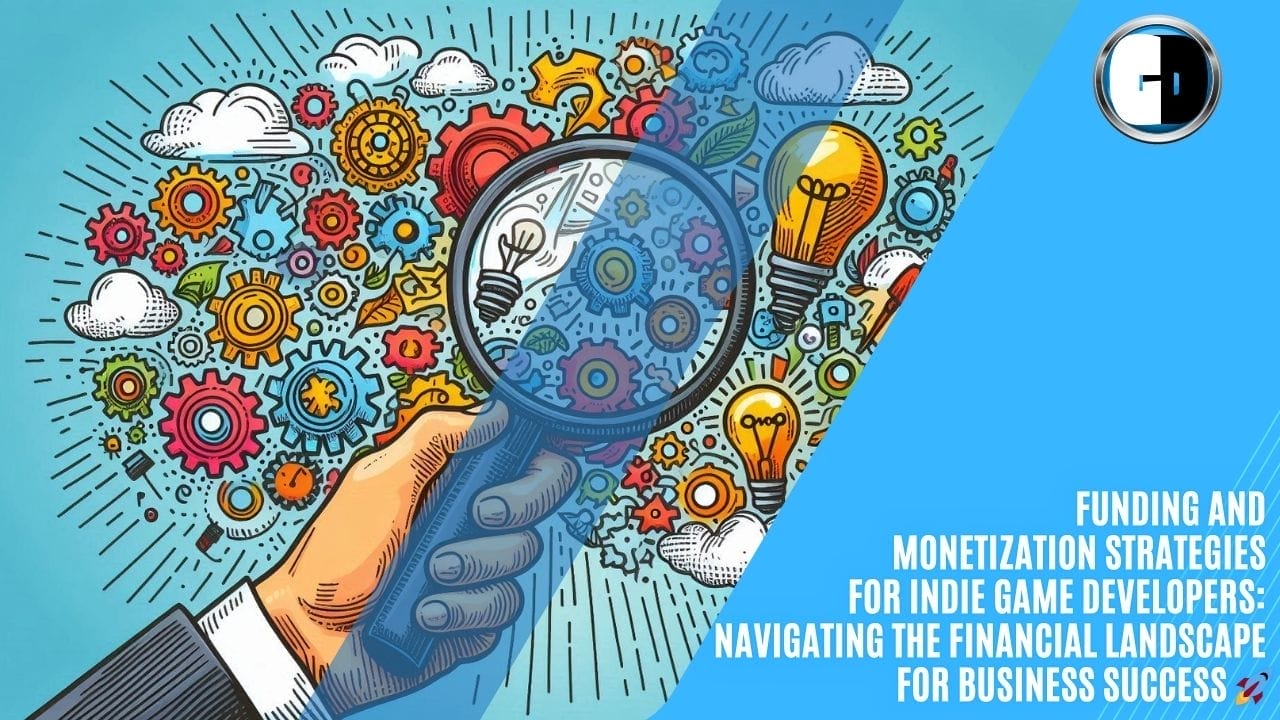Funding and Monetization Strategies for indie game developers: The Financial Backbone of Business
Funding and monetization strategies form the bedrock of business sustainability and growth. These crucial elements encompass a wide array of methods, from tried-and-true bank loans to cutting-edge crowdfunding campaigns. Each approach offers unique advantages and challenges, making strategic selection vital for success.
Bootstrapping, a classic tactic, allows entrepreneurs to maintain full control over their ventures. This method involves using personal resources and reinvesting company-generated revenue to fuel growth What Is Bootstrapping? It’s Definition and Uses – Shopify. On the flip side, modern businesses increasingly leverage sophisticated analytics to optimize monetization strategies. They track key performance indicators (KPIs) like conversion rates and customer lifetime value What is a Monetisation Strategy? What are some Examples?.
Crowdfunding has gained immense popularity, especially for startups and creative projects. This approach requires meticulous planning and compelling storytelling to attract potential backers The Complete Guide to Crowdfunding: The What, Why, Where, and How – Oberlo.
Key Takeaways:
- Diverse funding options exist, from traditional bank loans to modern crowdfunding platforms
- Monetization strategies should align with business goals and target audience
- Regional differences significantly impact funding availability and startup ecosystems
- Emerging trends like sustainable investments and data-driven decision-making shape the future of venture capital
- Alternative funding sources offer flexibility but often come with higher costs

Traditional Funding Strategies: Old School Still Rules
Bank Loans: The Tried and True
Bank loans remain a popular choice for established businesses. They offer lower interest rates and comprehensive financial services. However, securing a bank loan ain’t no walk in the park. Businesses must demonstrate strong credit histories, substantial collateral, and well-documented business plans Traditional Banks vs. Alternative Funding: Finding the Best Fit for ….
Advantages of Bank Loans:
- Lower interest rates
- Access to additional financial services
- Potential for long-term relationships with financial institutions
Disadvantages of Bank Loans:
- Lengthy approval processes
- Stringent lending criteria
- Difficulty for startups or businesses with poor credit
Debt Financing: Borrowing Your Way to Success
Debt financing involves borrowing capital and agreeing to repay it with interest. Common forms include loans, bonds, bills, and notes Debt vs Equity Financing: Which is best? – Overview, Examples.
Advantages of Debt Financing:
- Lender doesn’t gain control over the business
- Interest payments often tax-deductible
- Predictable financial planning with fixed loan payments
Disadvantages of Debt Financing:
- Obligation to repay loan with interest
- Potential strain on business finances
- Possible covenants or restrictions on business activities

Modern Funding Strategies: New Age Solutions 💡
Crowdfunding: Power to the People
Crowdfunding involves raising small amounts of money from a large number of individuals. This method leverages social media and crowdfunding websites to connect investors and entrepreneurs 15 Crowdfunding Examples – Small Business Trends.
The global crowdfunding market volume reached an estimated $1.17 billion in 2023. Platforms like Kickstarter and Indiegogo offer different rules and flexibility. For instance, Kickstarter prohibits projects involving charity donations, while Indiegogo allows campaigners to choose between fixed and flexible funding models.
Debt-Based Crowdfunding: Peer-to-Peer Lending
Debt-based crowdfunding, also known as “peer-to-peer” (P2P) lending, involves borrowers applying online for loans. An automated system reviews and verifies applications, determining credit risk and interest rates. Investors then buy securities in a fund that makes loans to individual borrowers.
P2P lending experienced significant growth when institutional investors entered the arena. For example, Google invested a whopping $125 million in Lending Club back in 2013.
Alternative Funding Sources: Thinking Outside the Box
Alternative funding sources, such as online lenders and invoice financing companies, offer flexibility and quick approval processes. These options often have more lenient qualification requirements, making them attractive to startups and small businesses 8 Alternative Funding Options for Small Businesses | Bplans.

Monetization Strategies: Show Me the Money 💰
A solid monetization strategy serves as a well-structured plan to generate revenue from a specific platform, audience, or type of content. It’s crucial to align this strategy with business goals, products, market, and user base to ensure maximum effectiveness.
Subscription Model: Recurring Revenue
The subscription model involves customers making regular payments to access a product or service. Businesses often offer different pricing tiers, each with unique features and costs. Many also provide free trial periods, allowing users to experience the app’s features before purchasing.
For example, Disco, a leading community platform for learning communities, offers a subscription-based pricing model with four distinct tiers, catering to different levels of customer readiness in community building and management.
Advertising-Based Model: Eyeballs for Sale
The advertising-based model generates revenue by displaying advertisements to users. This strategy works best for platforms with high user engagement, such as media sites, social networks, and game apps.
YouTube began its monetization journey through an advertising-based model before introducing YouTube Premium. This strategy allowed the platform to offer a vast library of videos to users for free while generating revenue from ad placements.
In-App Purchases: Microtransactions for the Win
In-app purchases refer to additional items, events, or content that users can buy within an app after installation. These transactions may constitute one-time sales or contribute to monthly subscriptions, providing an additional revenue source for app developers.
Licensing and Franchising: Spreading Your Brand
Licensing and franchising involve licensing your intellectual property, trademarks, or brand assets to third parties in exchange for royalties or licensing fees. This approach expands a brand’s reach and generates passive income through licensing agreements.
Disney, for instance, licenses its iconic characters and franchises for use in merchandise, theme parks, and entertainment productions, creating additional revenue streams and extending brand visibility globally.

Funding Strategies by Region: A Global Perspective 🌍
North America: The Dominant Force
North America remains a powerhouse in the global startup ecosystem, particularly among the top 100 cities. The region captures a staggering 49.9% of global startup funding, underscoring its leadership position in the global market Traditional Banks vs. Alternative Funding: Finding the Best Fit for ….
Europe: Quantity over Quality?
Europe boasts the highest number of cities in the global top 1,000, with 410 cities in 2023. However, the region faces challenges in securing substantial investment compared to North America and Asia Pacific. One reason might be the lack of a common language, which can hinder the scalability of startups across different countries.
Asia Pacific: The Rising Star
The Asia Pacific region has seen tremendous growth in startup activity, establishing itself as a key player in global innovation. Countries like China, India, Singapore, and Australia are at the forefront, drawing significant attention from startups and investors worldwide. The region now secures 24.5% of global startup funding, reflecting its increasing influence.
Africa & Middle East: Israel Leads the Way
The Africa & Middle East region is experiencing a notable increase in funding, rising to 3.7% from 2.5% the previous year. Israel stands out within this region, capturing a staggering 53.3% of the funding allocated to Middle Eastern and African startups.
Latin America & Caribbean: Struggling but Promising
Latin America & the Caribbean lag behind other regions in terms of startup funding, securing only 2.2% of the global total in 2023. Nevertheless, countries like Brazil, Mexico, and Colombia stand out within the region, capturing over 70% of the available funding.
Emerging Trends: The Future of Funding and Monetization 🔮
Sustainable Investments: Green is the New Black
Venture capitalists are increasingly drawn to businesses that demonstrate not only financial promise but also a commitment to environmental sustainability and social responsibility.
Burgeoning Technologies: The Next Big Thing
Considerable growth is expected within emerging tech sectors such as artificial intelligence (AI), machine learning, fintech, biotech, and cybersecurity. These sectors present intriguing prospects for venture capitalists ready to navigate these new waters.
Data-Driven Decision Making: Numbers Don’t Lie
The integration of data-driven decision making is transforming how venture capitalists approach investments. Advanced analytics and AI enable more precise assessments of potential investments, helping to mitigate risks and identify promising opportunities.
Social Responsibility and Governance: Doing Well by Doing Good
Companies are increasingly expected to give back, take care of their employees, and maintain an ethical supply chain. Startups with strong policies that protect employees from misconduct, ensure nondiscriminatory hiring practices, and pay fair wages are being celebrated among investors and consumers alike.
Micro VC Funds: Small but Mighty
The emergence of micro VC funds has changed the landscape of venture capital investment. These funds typically invest smaller amounts of money in early-stage companies, focusing on pre-seed or seed-stage startups. Notable micro VC funds include Baseline Ventures, Cowboy Ventures, and Forerunner.
Focus on Profitability and Lean Operations: Tightening the Belt
In response to external economic pressures such as inflation and rising interest rates, startups are being urged to shift their focus to profitability. Lean operations, stringent cost control, and a sharp emphasis on revenue generation are becoming essential survival strategies.
Globalization and Founder Mobility: The World is Your Oyster
The globalization of the startup ecosystem is evidenced by various strategies aimed at attracting digital nomads and international entrepreneurs, the creation of co-working spaces outside of metropolitan centers, and leveraging EU research funding.

Alternative Funding Methods: Thinking Outside the Box 🎁
Alternative funding sources offer a variety of innovative solutions tailored to specific business needs, such as merchant cash advances and lines of credit. These sources are known for their flexibility and quick approval processes, which can be a significant advantage for businesses needing immediate access to funds.
Key Differences Between Traditional Banks and Alternative Funding
Approval Time: Speed is of the Essence
Traditional banks can take weeks or even months to approve and disburse funds, whereas alternative lenders typically offer much faster approval processes.
Qualification Criteria: Lowering the Bar
Alternative funding methods use different eligibility criteria compared to traditional loans. This allows businesses with bad credit or a short history of operations to potentially secure funding.
Loan Amounts: Size Matters
Alternative lenders offer various funding options with different loan amounts tailored to the specific needs of a business. While traditional banks may offer larger loans, the speed and flexibility of alternative funding can be more suitable for immediate or smaller-scale financial needs.
Types of Alternative Funding
Revenue-Based Financing: Sharing the Wealth
Revenue-based financing provides an upfront sum of capital in exchange for a share of future earnings. This type of financing is particularly suitable for companies with recurring revenue models, such as Software as a Service (SaaS) or subscription-based businesses.
Equity vs. Non-Equity Financing: To Share or Not to Share
With alternative financing, founders and financing partners have more tools to retain equity and avoid dilution. Options such as lines of credit and other debt products do not require giving up ownership in the business, unlike equity financing methods that involve selling a portion of the company to investors.
Other Methods: The Road Less Traveled
Other alternative funding methods include crowdfunding, angel investors, and venture capital. Each of these options comes with its own set of advantages and disadvantages, as well as varying eligibility criteria.

Challenges and Considerations: Navigating the Maze 🧭
When it comes to funding and monetization strategies, startups face a myriad of challenges that require careful consideration and strategic planning.
Talent Scarcity: The Human Element
One of the primary challenges is the scarcity of talent, particularly in regions like the UK’s B2B SaaS startup landscape. Talent scarcity can be mitigated by employing creative solutions such as hiring experienced professionals on a part-time or consultancy basis.
Regional Differences: One Size Doesn’t Fit All
The regional differences between the US and European startup ecosystems present unique challenges. American companies may not always be aware of the contrasting characteristics and natural advantages found in Europe, making it essential to adapt strategies and expectations to the local context.
Choosing the Right Monetization Model: The Million Dollar Question
For sustained revenue generation, especially in the tech industry, selecting the right monetization model is crucial. Models like in-app purchases require constant market research and iterative testing to adjust pricing based on geography and user demographics.
Regulatory Landscapes: Navigating the Red Tape
Navigating regulatory landscapes poses another significant hurdle. Improving the transparency of investment rules, streamlining administration procedures, and providing better information for investors can help startups overcome challenges related to market knowledge and regulatory requirements.
Conclusion: Charting Your Course to Success 🏆
Funding and monetization strategies form the backbone of any successful business venture. From traditional bank loans to cutting-edge crowdfunding platforms, the options are diverse and ever-evolving. The key lies in understanding your business needs, market conditions, and long-term goals to choose the most appropriate strategies.
As we’ve explored, regional differences play a significant role in shaping funding landscapes. North America continues to dominate, but regions like Asia Pacific are rapidly gaining ground. Emerging trends such as sustainable investments and data-driven decision-making are reshaping the venture capital industry, offering new opportunities and challenges.
Alternative funding methods provide flexibility and speed but often come at a higher cost. It’s crucial to weigh the pros and cons carefully before making a decision. Remember, the right funding strategy can propel your business to new heights, while the wrong one can hamper growth and stability.
In the end, success in funding and monetization boils down to understanding your options, adapting to market conditions, and making informed decisions. By staying informed about industry trends, regulatory changes, and emerging technologies, you can position your business for long-term success in an increasingly competitive landscape.
So, are you ready to take your business to the next level? The world of funding and monetization awaits, full of opportunities for those bold enough to seize them. Good luck on your journey to financial success! 🚀💰
A game developer that wants to share its knowledge and experience with other game developers-





